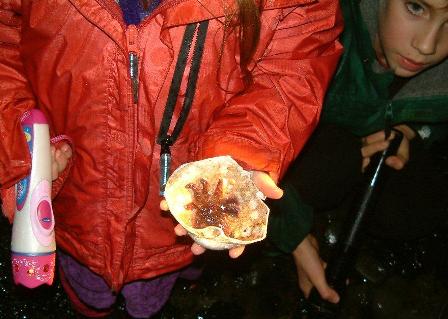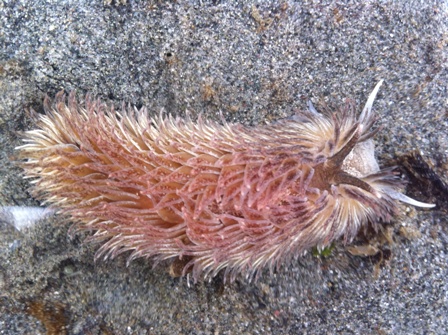Creatures of the Night
This Friday, Nov. 25 at 10:45 p.m., the new-moon tide will ebb to a rare low of -3.4 feet. Taking this opportunity to explore an island community normally hidden from view, the Vashon Beach Naturalists will host a free Starlight Low-Tide Walk at the north-end ferry dock from 9-11 p.m. Sip a hot chocolate as you head to the beach with a naturalist guide to discover dozens of denizens of the intertidal zone: nudibranchs (sea slugs), sea cucumbers, and sea pens to name a few.
Besides the fact that our local winter low tides occur only at night, this is a good time to get out for several reasons. At low tide on a hot summer day, animals that prefer cold, wet, and dark are stressed out and doing their best to hide. They’re in their comfort zone after dark, when you’re more likely to find light-sensitive creatures like octopuses. Also, animals tend to venture out of their designated tidal zones at night, making them easier to observe.
Intertidal secrets in the spotlight
With your visual field reduced to the circle created by a flashlight, it’s easier to focus your attention on every little detail…there’s incredible diversity to be discovered within one 12-inch diameter spotlight! Scour every rock closely to find animals like chitons—masters of camouflage these mollusks are hard to distinguish from the rocks they inhabit. Look for their oval shells made up of eight overlapping armor-like plates.
Vashon Beach Naturalist Sally Ammon says the highlight of the walk would be finding the evasive red octopus. She’s looking forward to seeing sea pens, which are often found near the end of the ferry dock. Belonging to the octocorals, or soft corals, these colonizing animals look like orange feather plumes sticking out of the sand; they have hundreds of eight-tentacled polyps on each of their soft “branches.” Beach visitors are sure to find crabs, sea cucumbers, limpets, and sea stars. Careful observers might also detect a telltale bump in the sand that indicates a hidden moon snail—these common local gastropods have a pretty round shell and an enormous pink, fleshy foot that can grow to three times the size of the shell. Moon snail mothers secrete their eggs in a gelatinous sheet that becomes coated with sand, leaving a donut-shaped ring behind. The resulting “sand collars” found on local shores each hold about a half-million moon snails-in-the-making.

Sunflower seastar (Pycnapodia helianthoides) found on a previous low tide evening. Photo by: Kathryn True
Respect for beach dwellers
Whenever you visit the beach, remember these beach naturalist guidelines to help protect the health and safety of our intertidal neighbors: Don’t walk on eel grass or in tidepools, wet your hands with saltwater before touching the animals to protect their sensitive skin, return animals to where you found them, don’t move a rock larger than your head, and carefully replace any rocks you move.
Want to read up on what to look for? Two of Sally’s favorite field guides are Whelks to Whales: Coastal Marine Life of the Pacific Northwest, and Pacific Reef& Shore: A Photo Guide to Northwest Marine Life, both by Rick M. Harbo.
If you can’t make it this Friday, take a virtual beach walk with these resources from the Seattle Aquarium: http://www.seattleaquarium.org/page.aspx?pid=862. Look for some of the creatures mentioned in this post in their “Marine Invertebrate” Powerpoint.
Walk logistics: Park in the north end ferry parking lot and walk down the hill to meet the naturalists at a tent across from La Playa. Dress warmly in layers, bring raingear, and wear sturdy, non-slip boots. Bring a flashlight with a strong, directed beam (lanterns do not work as well), and an insulated cup to fill with hot cocoa.
If you go and get some great pictures send them along to us at Vashon Nature Center: info@vashonnaturecenter.org
HAVE FUN!!!!

